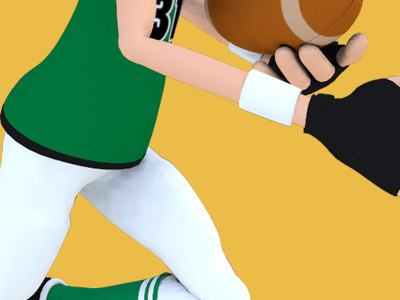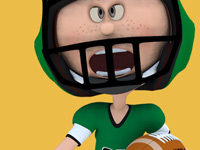American football

American football Turnover on downs
In American football and Canadian football, a turnover on downs occurs when a team has used up its allotment of downs but has not progressed downfield enough to earn another set of downs.
In American football, both indoor and outdoor, a team has four chances (each chance is called a "down") to gain ten yards or to score. Any ground gained during each down short of these ten yards is kept for the next chance, and any ground lost must be regained in addition to the ten yards. Thus, if a team gains four yards on first down, it then has three chances to gain the six remaining yards, and if a team loses four yards on first down then it must gain a total of fourteen yards over the next three chances. If a team gains the required ten yards, it receives another four downs to gain another ten yards (an event called a "first down") or cross the goal line for a score. The same principles apply in Canadian football, except that a team has only three chances to gain ten yards instead of four.
In most cases, teams will use one less chance (i.e. three in American football, two in Canadian football) than they are permitted to try to gain a first down. Usually, if a team has failed to gain the needed yardage when playing its final down, it will then punt the ball, offering the opposing team possession (the kicking team aims to place the ball downfield), or attempt to kick a field goal if close enough (typically within 30 yards of the opponent's end zone). In the event of a successful punt, the opposing team will start its new set of downs at the spot the punt returner can advance the ball to before being tackled (or goes out of bounds), or where the punt goes out of bounds, or (in American football only) where the punt comes to rest when rolling to a stop or at the spot where the punt is fair-caught.
But in some instances, a team may elect to use its last down to try to gain the yardage, rather than punt. This is often referred to as "going for it" or "sticking" (as opposed to "kicking"). This disadvantage is that if this conversion attempt fails, the opposing team will immediately take possession of the ball at the spot where the play ended, rather than (usually) much farther away from a score in the case of a punt. Factors that may lead to a team making this choice are:
- Only a small distance is needed to gain a first down (either fourth-and-short or fourth-and-goal)
- A team is close to, but not within field goal range, such that a punt may not net very many yards (in American football, if the punt reaches the end zone, the opposing team will get the ball on the 20-yard line).
- A team believes it has a chance to convert the first down by way of a fake punt or a fake field goal.
- The game's end is near, and if the team surrenders possession of the ball, it may not have another chance to score what is needed to win or tie the game.
- The game's end is near, and if the team is in field goal range but is trailing such that a field goal would not tie or win the game, but a touchdown would.
- In certain situations near the end of the game the team on fourth down may attempt it to prevent the opposing teams offense from possessing the ball.
- Finally, if there is no obvious reason to attempt a conversion, a team may nevertheless attempt one if it believes the attempt will surprise the defense or catch it off-balance.
Turnovers on downs are not counted in a team's turnover total, which tallies turnovers occurring during a play (such as fumble recoveries and interceptions).
SPORTS



American Football
Game play in American football consists of a series of downs, individual plays of short duration, outside of which the ball is dead or not in play. These can be plays from scrimmage – passes, runs, punts, or field goal attempts (from either a place kick or a drop kick) – or free kicks such as kickoffs and fair catch kicks. Substitutions can be made between downs, which allows for a great deal of specialization as coaches choose the players best suited for each particular situation. During a play, each team should have no more than 11 players on the field, and each of them has specific tasks assigned for that specific play.
Rules and gameplay
- Scoring
- Maneuvers
- Strategy
- Play types
- Penalties
- Turnovers
- Downs
- Teams and positions
- Field
- Equipment
- Duration and time stoppages
- Advancing the ball and downs
- Kicking
- Officials and fouls
Positions
Offensive (Interior) line
Backs and receivers
Defensive line
Linebackers
Defensive backs
Special teams
- Kicker (K)
- Holder (H)
- Long snapper (LS)
- Punter (P)
- Kickoff specialist (KOS)
- Kick returner (KR) and Punt returner (PR)
- Upback
- Gunner
- Jammer


RESOURCES
This article uses material from the Wikipedia articles "American football", "American football rules", "Turnover on downs", which is released under the Creative Commons Attribution-Share-Alike License 3.0.
© Stories Preschool. All Rights Reserved.





